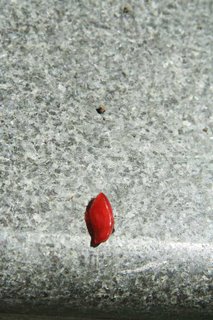I have recently taken a photographic course called 'Miksang'. Miksang is Tibetan for 'good eye' and the art was introduced by a Buddhist teacher that learnt several art forms including poetry and photography.
The idea is that one enters the world and awaits 'flashes of perception' that reveal the true nature of things. These perceptions are then caught on camera for others to experience. So, normally, when one walks down a road and sees a car or bus or person, your mind immediately labels them as a car, a bus, a person, and then goes on to judge them: I like the car, I don't care about the bus, I don't like the person. In Miksang, one stops the mind from labelling and judging images and simply allows one to see them as they are: for their colour, texture and for the light falling.
So, as one walks down a road, the sight of bright yellow with hues of blue catches your eye: it is the reflection on the side of a yellow car but you train your mind to only see the colours. One then stops and connects with this image that stopped you. You ask yourself what is it that actually stopped me? Was it only the yellow and the reflected blue or was it also the top part of the wheel, the side of the door. Once you have discerned the image, worked out what actually stopped you, you can see the composition in your mind. You then, at the last stage of the process, raise the camera and take the photo. In Miksang, photography is only 10% of the 'art'.
I have four images below that sort of gives you an idea as to what I mean. Comments on this style of photography are welcome but the photos are just examples and are not there to be rated. If you are interested, the website is www.miksang.net
Damian
 The yellow and green contrast 'stopped me ' as I walked past this restaurant in Halifax.
The yellow and green contrast 'stopped me ' as I walked past this restaurant in Halifax. The red colour of this discarded sweet against the grey stone caught my attention.
The red colour of this discarded sweet against the grey stone caught my attention. I walked past a small car park and at the end was an old mattress with these blankets thrown on them. The image immediately held me there for a while. As I walked up I worked out what actually stopped me, framed the image in my mind and then took the photo. It was the combination of the colour, the texture of the blankets and the light falling on the mattress that stopped me.
I walked past a small car park and at the end was an old mattress with these blankets thrown on them. The image immediately held me there for a while. As I walked up I worked out what actually stopped me, framed the image in my mind and then took the photo. It was the combination of the colour, the texture of the blankets and the light falling on the mattress that stopped me. I walked into a cafe and at the very end was this woman looking at the monitor. Again, this 'perception' stopped me completely. The blue dress, the drab wall colour, the monitors staring out, and the light. Oh, and her hand making the connection with the computer.
I walked into a cafe and at the very end was this woman looking at the monitor. Again, this 'perception' stopped me completely. The blue dress, the drab wall colour, the monitors staring out, and the light. Oh, and her hand making the connection with the computer.